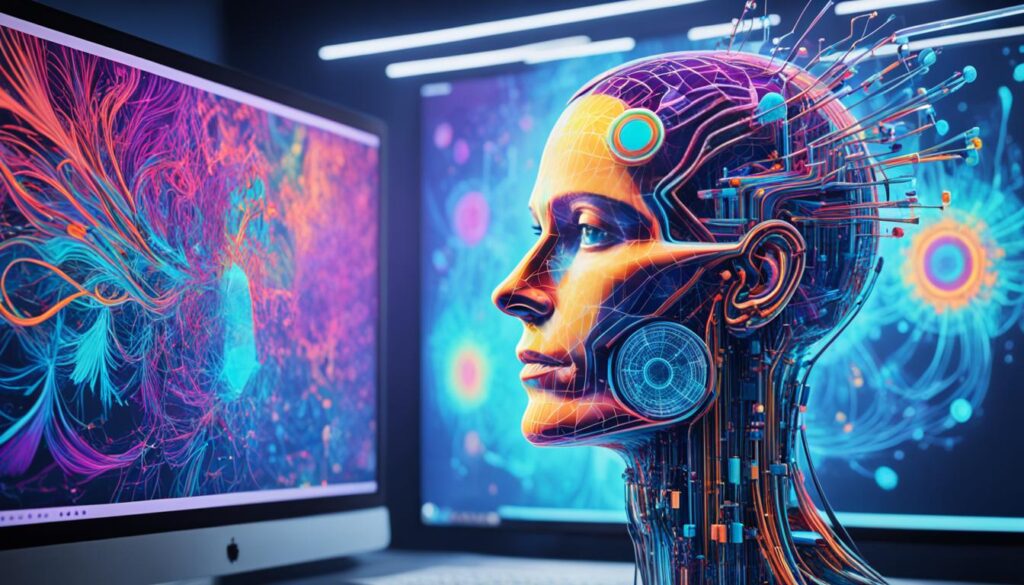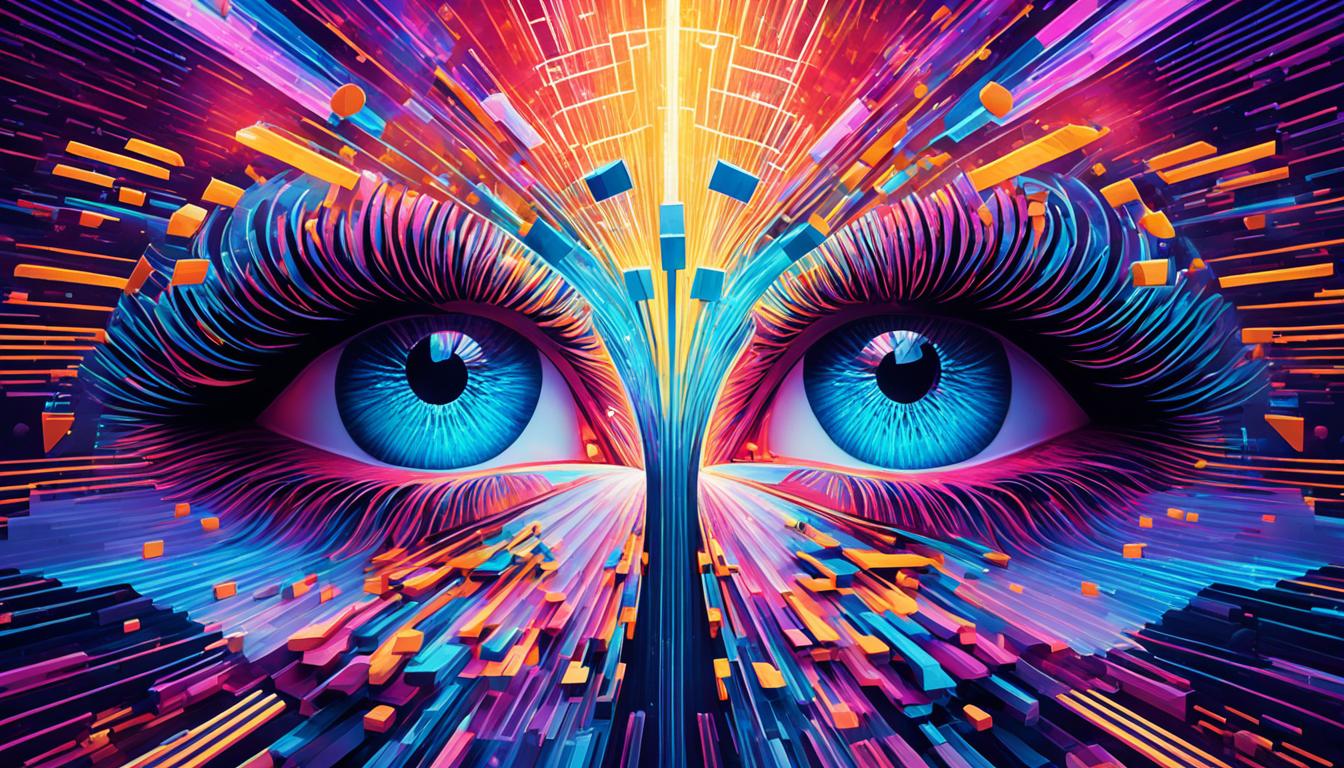Did you know that AI-generated artworks sold as NFTs have reached staggering sales of over $100 million in 2021?
Artificial Intelligence (AI) and Non-Fungible Tokens (NFTs) have emerged as game-changers in the art world, revolutionizing the way creativity is expressed, showcased, and valued. The fusion of these cutting-edge technologies has opened up new frontiers for artists, collectors, and enthusiasts alike.
Key Takeaways:
- AI and NFTs have reshaped the art market by providing a digital medium for artists to create, exhibit, and trade their unique digital assets.
- Generative AI algorithms, like OpenAI’s DALL·E and DeepArt.io, are instrumental in inspiring and assisting artists in the creative process.
- The collaboration between human artists and AI algorithms has led to the creation of dynamic and interactive digital art experiences.
- The future holds promising prospects for AI adoption in NFT creation, AI-powered curation, authentication, blockchain integration, and the democratization of the art market.
- The fusion of creativity and technology through AI and NFTs paves the way for groundbreaking artistic expressions and attracts a new audience to the world of art.
Understanding AI and NFTs
Artificial Intelligence (AI) refers to the simulation of human intelligence in machines, enabling them to perform tasks that typically require human intelligence. In the creative field, AI is revolutionizing the way art is generated, music is composed, and designs are created. By leveraging AI algorithms, artists can explore new avenues of creativity and push the boundaries of traditional artistic styles.
Non-Fungible Tokens (NFTs) have emerged as a game-changer in the art world, utilizing blockchain technology to provide a unique digital medium for artists to showcase and sell their work. Unlike cryptocurrencies like Bitcoin, NFTs represent ownership of a specific item or piece of content, whether it’s a digital artwork, a music album, or a virtual asset in a game.
The growth and demand for AI-generated NFTs stem from the potential for rarity and novelty they offer. AI algorithms can generate unique and one-of-a-kind digital assets that appeal to collectors and enthusiasts in the art market. Combining the creativity of human artists with AI algorithms introduces a collaborative approach to art creation, yielding innovative and captivating pieces.
The Role of AI in the Creative Field
AI has found a profound place in the creative field, empowering artists and designers with powerful tools and capabilities. The use of generative AI algorithms, such as deep learning models, helps artists generate new ideas, patterns, and concepts.
AI algorithms assist artists in creating unique and novel digital artworks, revolutionizing the way art is conceptualized and produced. By leveraging AI, artists can explore uncharted territories of creativity and delve into new artistic styles.
Moreover, AI-powered tools aid in the creation of music and design. From algorithmic composition to machine-generated visual designs, AI algorithms augment human creativity, offering new perspectives and possibilities.
The Advantages of NFTs
With the rise of blockchain technology, NFTs have opened up new opportunities for artists to monetize their digital creations. By tokenizing their work, artists can establish provenance, ownership, and scarcity for their digital assets.
NFTs enable artists to sell their digital artworks directly to collectors, bypassing traditional intermediaries. Through smart contracts, artists can also receive royalties with every subsequent sale of their NFT, ensuring ongoing financial support and recognition for their artistic contributions.
Additionally, NFTs provide collectors and art enthusiasts with an enhanced and immersive digital art experience. Owning an NFT allows individuals to showcase their digital acquisitions, participate in virtual exhibitions, and engage in a vibrant online art community.
As the intersection of AI and NFTs continues to evolve, it presents endless possibilities for the future of the creative field. The fusion of creativity and technology has the potential to reshape the art market, democratize artistic expression, and elevate the understanding and appreciation of digital art.
The Rise of Generative AI and AI-Assisted NFT Creation
In the world of art and technology, the fusion of Generative AI and AI-assisted NFT creation has revolutionized the creative process. Artists now have access to powerful AI algorithms that inspire and assist them in generating unique and innovative NFTs.
Generative AI algorithms, such as OpenAI’s DALL·E and DeepArt.io, leverage deep learning and generative models to push the boundaries of artistic expression. By analyzing vast amounts of data and patterns, these algorithms can generate new ideas and concepts that human artists may not have considered.
The collaboration between AI and artists leads to the creation of captivating AI-assisted NFTs. These NFTs possess a distinct blend of human creativity and AI-generated elements, resulting in artworks that capture the attention of collectors and enthusiasts alike.
One exciting development in this field is the emergence of Dynamic Non-Fungible Tokens (DNFTs). Powered by AI, DNFTs are digital assets that evolve and change over time, offering a dynamic and interactive digital art experience. This innovation adds a new dimension to the world of art, allowing viewers and collectors to engage with art in ways previously unimaginable.

Through Generative AI and AI-assisted NFT creation, artists can explore new artistic possibilities, experiment with different styles, and challenge traditional concepts of art. This exciting combination of human creativity and machine intelligence opens doors to endless opportunities for innovation and artistic expression.
Future Prospects and Innovations
The future of AI and NFTs holds immense potential for innovation and impact. As the adoption of AI continues to grow, we can expect an increase in AI-powered tools for NFT creation. These tools will empower artists with new and exciting creative possibilities, pushing the boundaries of artistic expression.
One exciting area of development is AI-powered curation in NFT marketplaces. Utilizing sophisticated algorithms, AI will personalize NFT discovery, making it easier for art enthusiasts to find pieces that resonate with their tastes. This AI-powered curation will enhance the overall user experience, facilitating meaningful connections between artists and collectors.
In addition to curation, advanced authentication techniques powered by AI will play a crucial role in ensuring secure and trustworthy transactions in the world of NFTs. AI algorithms can analyze and verify the authenticity of digital artwork, providing artists and buyers with confidence in the provenance of their NFTs.
Furthermore, the integration of blockchain technology and AI will enhance transparency and traceability in the world of AI-generated NFTs. Blockchain’s decentralized nature combined with AI’s ability to analyze data and patterns will pave the way for verifiable and immutable records of ownership, revolutionizing the art market.
Looking ahead, AI algorithms will continue to refine art styles and techniques, collaborating with virtual reality (VR) environments to create immersive digital experiences. This collaboration between AI and VR will democratize the art market by making art accessible to a wider audience, regardless of physical location or financial constraints. Moreover, AI will transform art valuation and ownership by introducing new methods and models of evaluating and trading NFTs, challenging traditional notions of artistic worth.
In conclusion, the future of AI and NFTs is characterized by AI adoption, AI-powered curation, authentication, and blockchain integration. These advancements will shape the way artists create and showcase their work, while also enhancing the art-collector relationship. As technology continues to evolve, the fusion of creativity and technology will pave the way for new and exciting possibilities in the world of AI art and NFTs.
FAQ
What is AI and how is it used in the creative field?
What are NFTs and how do they relate to AI art?
How do generative AI algorithms contribute to NFT creation?
What are Dynamic Non-Fungible Tokens (DNFTs) and how do they enhance the digital art experience?
What can we expect in the future of AI and NFTs?
Source Links
- https://medium.com/@seaflux/synergizing-creativity-the-intersection-of-ai-and-nfts-68ed8f7f6b99
- https://www.linkedin.com/pulse/fusion-creativity-tech-dive-ai-art-kehinde-eyebiokin
- https://www.prnewswire.com/news-releases/surrai-celebrates-a-year-of-groundbreaking-colorful-fusion-merging-human-creativity-and-ai-to-shape-the-future-of-blockchain-secured-digital-art-302090390.html

Leave a Reply